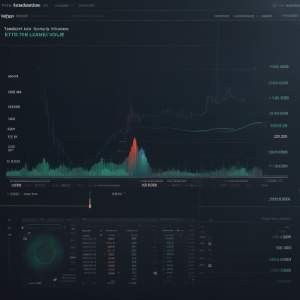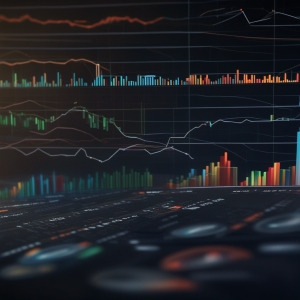Welcome to another value-packed article on Bitopex. Our goal remains to demystify the world of cryptocurrency trading, helping you navigate your way confidently. Today, we're honing in on chart analysis – a critical skill every crypto enthusiast should master. We'll break it all down and give you handy chart analysis tips to up your trading game.
Introduction: Understanding the Importance of Chart Analysis
Chart analysis, also known as technical analysis, is one of the most crucial elements in cryptocurrency trading. It's a method used to evaluate securities and forecast future price movements by analyzing statistics gathered from trading activity such as price movement and volume. Understanding chart analysis gives traders the power to spot trends, identify potential entry points, and make informed trading decisions.
Without knowledge of chart analysis, traders are essentially 'flying blind', relying solely on luck and hearsay. However, by mastering chart analysis, traders gain the tools to anticipate market movements and make decisions backed by concrete data. Ultimately, this combination of skills and knowledge can help reduce risk and increase potential returns. Stay with us as we delve into crucial chart analysis tips that every crypto enthusiast can use.
Main Concepts in Chart Analysis
Before we explore our chart analysis tips, it's necessary to understand some foundational concepts integral to chart analysis. These include price trends, support and resistance levels, and volume data.
Price Trends are the general direction in which the price of an asset is moving. Trends can be upward (bullish), downward (bearish), or sideways (neutral). Understanding these trends is vital because they help you predict future price patterns and make profitable trades.
Support and Resistance Levels, on the other hand, are specific price points at which a cryptocurrency tends to stop and reverse direction. Resistance is a level that a price has trouble exceeding, while support is a level which a price has difficulty falling below.
Lastly, Volume Data represents the total amount of a cryptocurrency that was traded during a specific period. When combined with price trends and support and resistance levels, volume data gives a well-rounded snapshot of market activity and helps traders gauge the strength of a price movement.
With a basic understanding of these critical chart analysis components, we can now move on to specific tips and tricks that will help improve your chart analysis skills.
Pros and Cons of Mastering Chart Analysis for Crypto Enthusiasts
| Pros | Cons |
|---|---|
| Ability to predict market trends | May encourage over-speculation |
| Aids in investment decisions | Not always 100% accurate |
| Helps in minimizing risks | Requires time and effort to learn and understand |
| Grants a deeper understanding of the market | Can cause stress and anxiety if not managed properly |
The Role of Trends in Chart Analysis

In making trading decisions, understanding the role of trends in chart analysis is paramount. Trends help traders understand the general market sentiment and provide clues about potential future price movements. There are three primary types of trends:
Uptrend: This trend is characterized by a series of higher highs and higher lows on the chart. It signals that prices are generally increasing, and it's often a good time to consider buying or holding onto the cryptocurrency.
Downtrend: A downtrend is represented by a series of lower highs and lower lows on the chart. It illustrates a general decrease in price, potentially indicating a good time to sell or short-market the cryptocurrency.
Sideways Trend: Also known as a horizontal trend, this movement shows a period of indecision in the market with prices moving within a narrow range. It's an ideal time for traders to observe and wait for clear signals before taking action.
Bearing these trends in mind during chart analysis can provide valuable information about market behavior and contribute greatly to trading strategy development.
Candlestick Patterns: Your Secret Weapon
Among the chart analysis tips you'll encounter, making use of candlestick patterns is one you should pay close attention to. Named for their resemblance to lit candles and their wicks, candlestick patterns are graphic representations of price movements in a specific timeframe.
Each candlestick consists of a body, which represents the opening and closing prices, and the wicks, which signify the highest and lowest prices during that timeframe. By clustering these candlesticks, traders can discern patterns that tend to forecast future price movements.
There are numerous candlestick patterns to learn, but some of the most commonly used in cryptocurrency trading include Bullish Engulfing, Bearish Engulfing, Hammer, Inverted Hammer, and Doji. Understanding these patterns can provide deeper insights into market sentiment and enhance your decision-making process.
For example, a Bullish Engulfing pattern, characterized by a small candle followed by a larger one that 'engulfs' the previous candle, usually signals a potential reversal from a bearish trend to a bullish one. Similarly, a Doji, which has a very thin body, indicates uncertainty in the market, signaling that a reversal may be near.
Mastering candlestick patterns will take practice, but the payoff will be an invaluable addition to your chart analysis toolbox, giving you the edge in spotting market trends and making timely, informed trading decisions.
Trading Volume: An often overlooked indicator

The significance of trading volume in chart analysis is usually underrated, but it's a factor that can drastically sharpen your forecasting abilities. Think of trading volume as the fuel that powers market trends. It shows the number of shares or contracts traded in a security or market during a given period.
A sudden increase in trading volume tends to validate a current trend, implying that the trend is likely to continue. Conversely, decreasing volume might indicate a forthcoming change in trend, signaling that the trend may be nearing its end. When combined with other chart indicators, trading volume forms a vital piece of the puzzle, helping to create a more holistic view of the market direction.
Examining trading volume can also help identify significant price levels, better known as support and resistance. When a significant number of trades occur at a particular price level, it can signify a key level of supply (resistance) or demand (support). Traders can use this information to set strategic entry and exit points, optimizing trading results.
Empire gem, consistently checking trading volumes and understanding their implications can have a substantial positive impact on your chart analysis outcomes. Remember, chart analysis is not just about price movements, it's about understanding the complete market activity, and trading volume is an essential part of this comprehension.
Useful Chart Analysis Tools
Empowering your trading strategy further, certain tools can help simplify chart analysis and enhance your understanding of market trends. Here are some of the essential chart analysis tools you should get familiar with.
Moving Averages (MA): By averaging the closing prices over a specific period, Moving Averages enable traders to smooth out price data and spot underlying trends clearly. The two main types of MAs are Simple Moving Average (SMA) and Exponential Moving Average (EMA). EMA gives more weight to the latest prices, making it more responsive to recent price changes.
Relative Strength Index (RSI): This is a momentum oscillator that measures the speed and change of price movements. RSI oscillates between zero and 100. Traditionally, a cryptocurrency is considered overbought when the RSI is above 70 (potentially signaling a future price drop) and oversold when it's below 30 (indicating a possible price increase).
Bollinger Bands: These are volatility bands placed above and below a moving average. They are used to identify overbought and oversold levels, potential reversals, and price volatility. Bollinger Bands consist of an upper band, lower band, and a middle band which is the SMA.
MACD: The Moving Average Convergence Divergence (MACD) is a momentum-based indicator that follows trends and shows the relationship between two moving averages of a cryptocurrency's price. Trading signals are given when the MACD line crosses the signal line.
Gain proficiency in these tools and more to maximize the effectiveness of your chart analysis endeavor. Always remember, though, that no single tool provides a surefire route to trading success. Diversify your analytical array and be prepared to adapt your strategy according to market changes.
Top 3 Chart Analysis Tips & Tricks

Now that we've covered some core concepts and principles on chart analysis let’s delve into three specific tips and tricks that can elevate your trading game. These practical strategies will directly help you in the live markets:
1. Always Consider Multiple Timeframes: Viewing charts in multiple timeframes can provide a broader perspective on the market. For instance, something that appears as a buying opportunity on a daily chart could look like a sell signal on a weekly chart. This makes it imperative that traders look at multiple timeframes before making a decision.
2. Pay Attention to Volume: A price move is generally considered stronger if it has a high trading volume. This is because volume tends to confirm the trend. If prices are moving up on high volume, it's a strong bullish signal. On the other hand, a price drop on low volume might just be a temporary pullback.
3. Incorporate Indicators: Trading indicators like Moving Averages, Relative Strength Index (RSI), and Bollinger Bands can provide valuable insights to supplement your chart analysis. These indicators can send buy or sell signals and identify overbought or oversold conditions.
Each of these tips can enhance your chart analysis skills, helping you make more informed trading decisions. Remember that chart analysis is as much about experience as it is about knowledge. So, practice frequently and review your trades to continually improve.
The Importance of Patience and Discipline in Chart Analysis
Let's now shift our focus to a non-technical, yet crucial aspect of chart analysis - the virtue of patience and the need for discipline. These are two key intangible assets that are just as important as your practical analysis skills.
Traders, particularly those new to the crypto world, can often get caught up in the excitement of the volatility of digital currencies. This could lead to impulsive decisions and skipping the necessary step of comprehensive chart analysis. However, patience is required to wait for the confirmation of trends and signals before making a trade. Misreading or rushing this process can often lead to avoidable losses.
Alongside patience, discipline plays a vital role in successful chart analysis. Following your set trading plan, using stop-loss orders, and not giving in to emotions are some examples of good trading discipline. Ignoring these principles could increase the risk in an already volatile crypto market, potentially leading to significant financial losses.
Remember, successful trading is not just about the number of trades made, but the strategic and disciplined approach to each trading decision. Enduring the natural ebb and flow of the crypto market is a challenge, but with patience and discipline, you can navigate with more confidence and efficacy.
Practising Your Chart Analysis Skills
Understanding the theoretical aspect of chart analysis is one thing, but putting theory into practice is where the real learning happens. Now that you've been equipped with the key concepts and chart analysis tips, it's time for you to apply these lessons.
Many trading platforms offer demo trading accounts where you can practise chart analysis without risking real money. These platforms will provide you with live market data and allow you to execute 'pretend' trades based on your chart analysis. It is a risk-free way of testing your understanding of the chart analysis concepts we've discussed.
When using a demo trading account, start by identifying various trends, noting support and resistance levels, and recognising different candlestick patterns. Then, make your trading decisions based on your analysis to see how they would play out. Review your decisions and their outcomes to improve your future analyses.
Remember, developing expert chart analysis skills will not happen overnight. It requires regular practice, along with a healthy dose of patience. When mistakes happen, treat them as learning opportunities and strive to make better-informed decisions in the future.
Another key to reinforcing your chart analysis skills is staying up-to-date with trading news and market updates. News events can often lead to dramatic changes in price and volume, providing real-world examples of chart patterns and trends. Utilizing a combination of both technical analysis and market news can dramatically improve your chart analysis skills.
Conclusion: The Power of Mastering Chart Analysis
Mastering chart analysis opens up a new world of opportunity. It empowers both novice and experienced cryptocurrency traders to decode market sentiments, recognize important patterns, and make informed decisions based on tried-and-tested metrics. This vastly improves your odds for success in the cryptocurrency market.
The understanding of price trends, utilization of candlestick patterns, and acknowledgement of volume data can be your compass in navigating the turbulent waves of crypto trading. Remember, practice is key. No tool in your trading toolkit is quite as powerful as the ongoing effort to continuously learn and refine your chart analysis skills.
By equipping yourself with these essential chart analysis tips, you are not only investing in your trading repertoire, but are also placing yourself on the road to potentially consistent trading success. Let the power of chart analysis elevate your trading game, and watch as the world of cryptocurrency becomes a more navigable, and potentially more profitable, journey.
Acquiring Proficiency in Chart Analysis for Crypto Lovers
What is Chart Analysis?
Chart Analysis, also known as technical analysis, involves predicting future price movements based on past patterns. It's highly used in the field of cryptocurrency trading.
Why is Chart Analysis Crucial in Crypto Trading?
Chart analysis helps to identify patterns and anticipate potential price movements. It can provide insights into market trends and signals for when to enter or exit trades.
What are some essential Chart Analysis Techniques for Crypto trading?
Some crucial techniques are Candlestick Patterns, Trend Lines Analysis, Volume Analysis, Moving Averages, and Relative Strength Index (RSI).
Does mastering Chart Analysis guarantee successful trades?
No technique ensures a 100% success rate in trading, including Chart Analysis. However, mastering it can significantly improve your risk management and increase your chances of successful trades.
Where can I learn more about Mastering Chart Analysis for Crypto?
You can learn more about this topic from online resources like cryptocurrency trading courses, ebooks, blogs, tutorials, and online forums.




